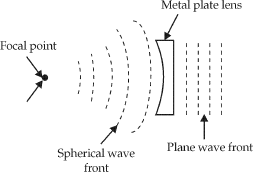Table of Contents
Electromagnetic (EM) Wave Propagation
Electromagnetic (EM) Wave Propagation: Electromagnetic wave in the frequency spectrum of 0.001 to 1016 Hertz is arbitrarily termed as radio waves, although broadly speaking by radio waves, means that band of electromagnetic energy which covers the frequency range from few kHz (very low frequencies or very long waves) to a few MHz (super-high frequencies or microwaves). So, electromagnetic wave and radio wave have the same meaning and hence the Electromagnetic wave propagation and radio wave propagation are the same.
Electromagnetic or Radio waves
Electromagnetic waves are nothing but oscillations that propagate with the velocity of light (approx. c = 3×108 m/s) in free space. An electromagnetic wave consists of moving fields of electric and magnetic forces. The lines of force in the electric and magnetic fields are at the right angle and they both are at the right angle to the direction of propagation. The figure is shown below, the direction of the ‘electric field’, the ‘magnetic field’ and ‘propagation’ are mutually perpendicular in electromagnetic waves. The electromagnetic waves are traverse in nature i.e. oscillations are perpendicular to the direction of propagation of waves. The simple electromagnetic wave is shown in the figure below, in which electric lines are perpendicular to the earth and magnetic lines horizontal. Arrows indicate the instantaneous direction of fields for a wave travelling towards the reader.

When Electromagnetic (EM) waves carrying information are generated by the transmitting antenna, they propagate towards the receiver after undergoing different phenomena.
Propagation Characteristics of EM wave
Let us consider the physical example of dropping a stone into a pool of water. When a stone is dropped in water, disturbances take place on the surface and the water moves up and down. This disturbance is transmitted in the form of expanding circles of waves. For example, if a leaf is placed on the surface, the leaf moves up and down with each wave passing under it. This type of wave produced under the above conditions is called a transverse wave.
A transverse wave is a wave that occurs in directions perpendicular to the direction of the propagation.
An EM wave radiated by a transmitting antenna is a transverse wave. A transverse wave is also called travelling wave.
When an EM wave is produced by an antenna it moves from the transmitter to the receiver in the following ways:
- A part of the wave travels along or near the surface of the earth. This wave is called the ground wave or surface wave.
- Some waves travel directly from the transmitting to the receiving antenna. That is, these waves do no follow the earth and also do not move towards the sky. These waves are called space waves.
- Some waves travel upwards into space towards the sky and get reflected back to the receiver. These waves are called sky waves.
EM Wave Characteristics
The radio waves of different frequencies have different propagation characteristics, the various parts of the frequency spectrum are used for different types of applications. The propagation characteristics of electromagnetic or radio waves are highly dependent on the frequency bands and their typical services. The table shows the different frequency bands and their typical services.
| S. No. | Frequency Band | Typical Services |
| 1 | VLF (3-30 kHz) | World wide telegraphy |
| 2 | LF (30-300 kHz) | Long-distance point-to-point services, Marine & navigational aids. |
| 3 | MF (300-3,000 kHz) | Broadcasting, Navigation, Harbour telephones etc. |
| 4 | HF (3-30 MHz) | short wave broadcasting to distant places. |
| 5 | VHF (30-3,000 MHz) | Short distance communication, TV, FM, Radar, Radio Relay, Telephony. |
| 6 | SHF (3,000-30,000 MHz) | Satellite Communication |
| 7 | EHF (30 GHz – 300 GHz) | Experimental purpose. |
Factors Involved in the Propagation of Radio Waves
As explained above, an EM wave/Radio wave travels from the transmitter to the receiver in three different types of waves:
- Ground wave or surface wave
- Space wave or tropospheric wave
- Skywave or ionospheric wave.
Ground wave which is also called surface wave exists when the transmitting and receiving antennas are close to the earth and are vertically polarised. This type of wave propagation is useful at broadcast and low frequencies. The broadcast signals received during the day-time are due to ground waves. It is useful for communication at VLF, LF and MF.
Space wave is also called a tropospheric wave. Here, the wave propagates directly from the transmitter to the receiver in the tropospheric region. The portion of the atmosphere above the earth and within 16 km is called troposphere. This is useful above the frequency of 30 MHz. FM reception is normally by space wave propagation.
Skywave is called ionospheric wave. The signal reception here is by reflection of the waves from the ionosphere. The ionosphere is an ionized region which lies approximately between 60 km to 450 km of atmosphere. Long-distance communication is possible through this mode of propagation. It is useful for frequencies between 2 to 30 MHz.
When an EM wave travels from the transmitter to the receiver, there are several factors that influence the propagation. The factors are:
- Earth’s characteristics in terms of conductivity, permittivity, and permeability.
- Frequency of operation.
- The polarisation of transmitting antenna.
- Height of the transmitting antenna.
- Transmitter power.
- The curvature of the earth.
- Obstacles between the transmitter and receiver.
- Electrical characteristics of the atmosphere in the tropospheric region.
- Moisture content in the troposphere.
- Characteristics of the ionosphere.
- Earth’s magnetic field.
- Refractive index of troposphere and ionosphere.
- The permittivity of the tropospheric and ionospheric regions.
- The distance between the transmitter and the receiver.
- The roughness of the earth.
- Type of earth like hilly terrain, forest, seawater or river water.



